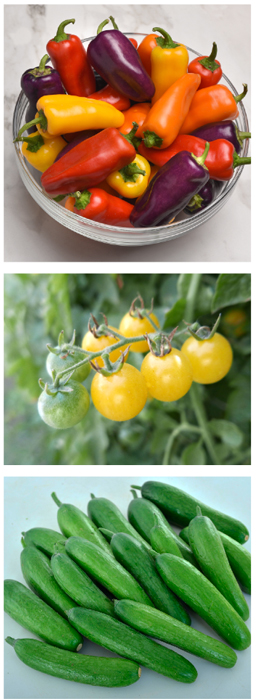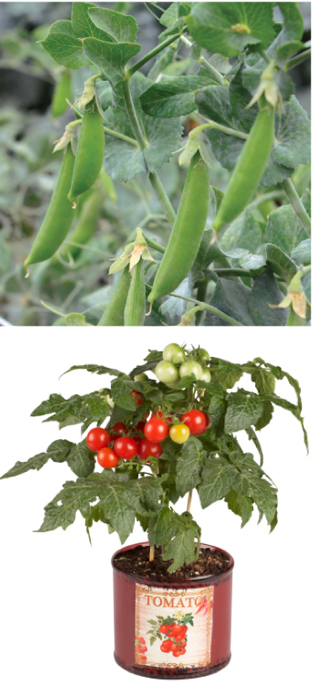11/1/2019
Power Snack
Jennifer Polanz
With everyone always on the go in today’s society, it’s no wonder the portable snacking category has jumped dramatically. What’s great is, so has the snacking vegetable side of that segment.
According to a 2017 Nielsen study, veggie snacking is big business: “Consumers are eating up this ‘on-the-go’ snacking sub-category to the tune of $1.1 billion dollars. Their hunger has grown the category at a compounded annual growth rate of 10% between 2012 and 2016.”
We reached out to a few industry experts to see how garden retailers can capitalize on this business. Of course, if you have a farmers market or grow your own, you can sell your snack-sized produce. But consumers also are interested in harvesting their own snacks, as long as they’re easy to grow, according to Patty Buskirk from Seeds by Design, a company that has a number of All-America Selections snacking varieties.
“When you’re talking about basic things in the retail garden center you ask, ‘Is it easy to grow? Am I going to be successful?’ You always have to think about that—I think that’s why people buy tomato and pepper starts, to be more successful.”
She adds that a lot of times hardcore gardeners buy their veggies out of catalogs and supplement in store, while newer gardeners buy starts and seeds based somewhat on impulse at retail. It’s an important distinction to keep in mind when trying to appeal to an in-store audience in the edibles aisle.
What’s Driving the Trend
Many consumers are either visiting a farmers market or taking part in a community-supported agriculture program (CSA), where they’re being introduced to new varieties, notes PanAmerican Seed’s Josh Kirschenbaum.
“When you carry that over to someone who wants to grow some of these herbs and veggies, or edibles in general, they want to grow the same things,” he adds. “That’s one reason why the snacking vegetables are popular on the retail side of it.”
There are a couple more aspects, too, including single people and smaller family units who don’t want to throw as much waste away, as well as people eating healthier and looking for fresh options to take on the go.
Taste and look also are big drivers of the trend. “Ten years ago did anybody eat a colored cherry tomato?” Patty asks. “Now you can buy them all together in a nice clamshell at the grocery store. Fifteen years ago no one knew what heirloom tomatoes were. Now, one of our largest sellers is colored carrots because they don’t lose their color when cooked.”
That feeds into what Tiffany Heater, retail account manager for the Burpee Plant Program, says about what’s trending in the category.
“I think pretty foods are trending: purple broccoli, purple peppers, orange cauliflower, yellow tomatoes, purple carrots. ‘Look at this beautiful purple broccoli I grew!’” she says. “Does it taste any different than plain-old green? Maybe, maybe not, but it is all about the experience of growing and eating something different that makes it fun.”
Josh agrees. “Different colors and flavors are becoming so much more important to consumers, whether buying at the grocery store or growing it at home,” he says.
The big three for snacking tend to be cherry tomatoes, mini peppers and cucumbers, but there are some other options, too, that can be cooked. Josh mentions single-serve winter squash and butternut squash, while Tiffany talks about Brussels sprouts and Patty highlights purple potatoes.
What’s Coming
When we talk snacking, it’s important to note that the size of the fruit is smaller than traditional vegetables, but that doesn’t always translate to the size of the plant. Retailers should make it clear that while a cherry tomato plant might produce bite-sized tomatoes, it still could grow with a tall, bushy habit. However, PanAmerican Seed recently acquired the new line of Kitchen Mini plants that are ultra compact for patios and tabletops. That lines has tomatoes and peppers, and Josh says they’re working on adding cucumbers, too.
Patty, who’s in California, has noticed a definite uptick in Asian vegetables entering that market. She notes it’s important to watch for ethnic vegetable trends and make sure you cater to the needs and requests of your market.
It’s always a good idea to keep paying attention to social media, too, as consumers want to connect with retailers about their veggie plants and their harvest.
“Ask your customers where they are getting their information from to make sure you stay current with social media trends,” Tiffany advises. “Follow local garden writers, garden celebrities, national gardening organizations and the brands you are bringing into your garden center.
“Keep selling those old-fashioned vegetable varieties people have been buying for years if people are still buying them. But also be the one to introduce the new and exciting varieties.”


Newer Options for Snacking
1. The Mardi Gras Fun Pepper Collection from the Burpee Plant Program has sweet snack peppers in red, orange, yellow and even purple.
2. Firefly hybrid white cherry tomato from Seeds By Design was a 2019 All-America Selections winner for its juicy, sweet taste and disease resistance.
Photo Credit: All-America Selections.
3. Green Light Cucumber bred by Known-You Seeds is a mini cucumber, a snacking veggie that’s growing in popularity. An AAS Winner for 2020, judges said it had a higher yield than comparison varieties, plus “more attractive fruit, earlier maturity and superior eating quality.” Photo Credit: All-America Selections.
4. This one is a little older—introduced in 2015 by Sakata Seed’s Home Grown division—but it’s still worth highlighting for its size and snackability: Little SnapPea Crunch is a compact plant that produces loads of sugar snap peas in 58 to 60 days. Photo Credit: Sakata Seed.
5. The Kitchen Minis program from PanAmerican Seed features plants and fruit that are smaller and more compact. One example is the Siam Tomato, which is table-sized.
What’s Cooking in Snacks
Snack-sized veggies don’t just have to be raw—you can cook them, too. Here are a couple that fit the bill:
6. Grill it, stuff it or sauté it, but any way you cook Lemon Drop Squash from the Burpee Plant Program, it can be a single serving snack.
7. The 4-in., ball-shaped fruits produced by Bocce Squash from Sakata Seed is great for grilling, stuffing or slicing. Harvest for baby or mature fruit. Photo Credit: Sakata Seed.
8. Pretty purple and red Brussels Sprouts are prolific with Redarling Brussels Sprouts from Burpee Plant Program. There are lots of ways to prepare this healthy option as a snack or dinner side. GP